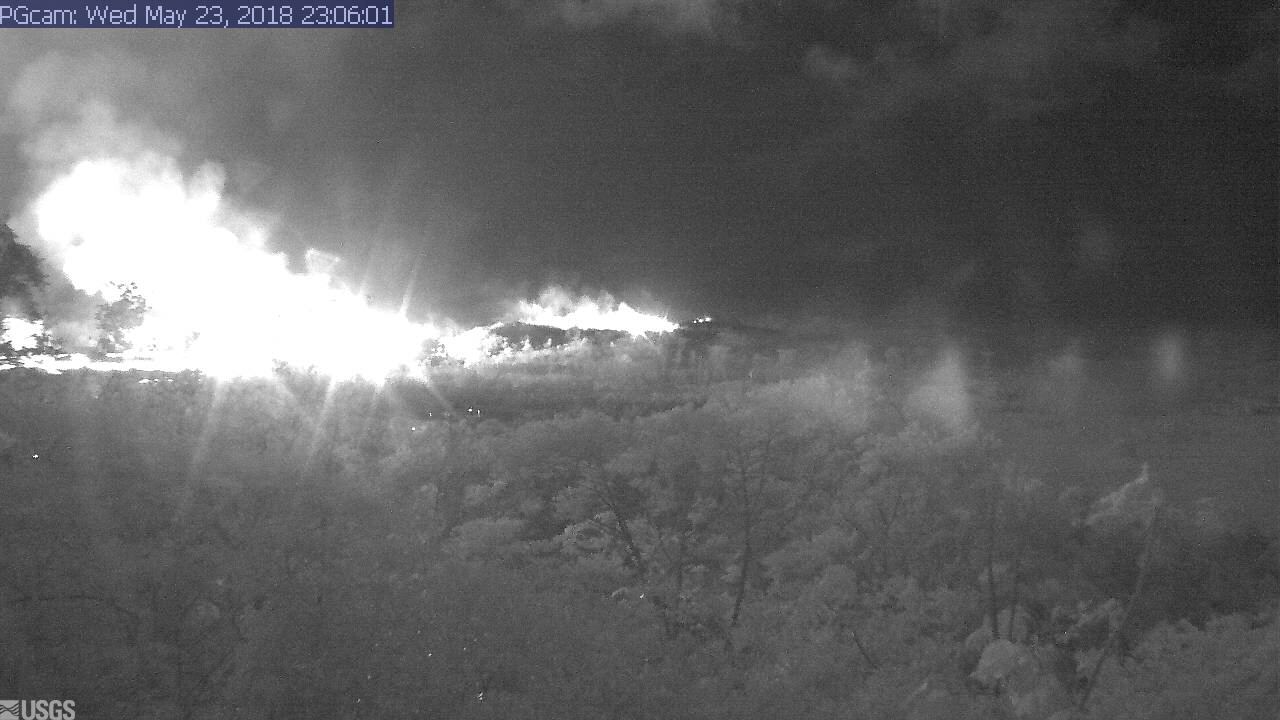Before this, the main thing USGS was using drones for was LIDAR, but today’s Photo & Multimedia entry on HVO’s website provides drone footage for both the summit steam/ash plume and Leilani/Puna lava flows.
SUMMIT ERUPTION:
This video was filmed on May 21, 2018, with a UAV (unmanned aerial vehicle). Limited UAV flights above the hazardous Kīlauea summit area, which is currently too dangerous for geologists to enter for ground observations, are conducted with permission from the National Park Service. […] At Kīlauea Volcano’s summit, a nearly continuous plume of gas and steam billows out of the Overlook vent and drifts with the wind. Explosions are occurring about two times a day, producing ash that rises to a height of between 8,000 to 10,000 feet above sea level. Small ash emissions occur more frequently. The larger explosions produce ash that is blown downwind, and trace amounts have fallen in nearby communities.
Addendum: there was a 6PM 10,000 foot ash explosion & plume this evening (Civil Defense photo, USGS video), sending ash southwest.
PUNA LAVA ERUPTION:
This footage is from an Unmanned Aircraft System (UAS) hovering near fissure 22 during the overnight hours of May 22, 2018, and looking down on the fountaining fissure complex. The view rotates upward (to the south) to track channelized lava as it flows toward the Pacific Ocean, about 3 mi (5 km) away. The ocean entry is in the distance, recognizable by a small plume. The USGS National Unmanned Aircraft Systems Project Office is assisting with remote data collection and mapping of lava flows and hazards…
HVO’s Photo & Multimedia blog also posted impressive Hilo Civil Air Patrol aerial photos of the lava rivers from yesterday, as well as an image of Fissure 22 taking a nap (it’s still going but lower today on Civil Beat’s Livestream) while the fissures west of it (and uprift) that activated yesterday inundated Leilani Estates.
As an aside: people keep posting ridiculous rumors, so the USGS had to reassure everybody that Mauna Loa is NOT erupting.
Latest video this evening from HNN reporter Mileka Lincoln:
#LeilaniEstatesEruption #KilaueaVolcano LATEST: Darkness falls on #LeilaniEstates this evening & the sky lights up with the intensity of 3 fountaining fissures where the road ends at Leilani Ave & Luana St https://t.co/9MZRnVNAGF @HawaiiNewsNow #HINews (Video: Leomana Turalde) pic.twitter.com/uooI4BUb9E
— Mileka Lincoln (@MilekaLincoln) May 25, 2018
Earlier in the day… welcome to the Leilani Estates Lava lake. (warning: noisy)
The residents are being absolute champs in coping with this. Here’s another video clip of the lava lake with the homeowner whose home is just outside of it. They’re very philosophical, realizing they took a gamble, which is more mature than some of the people criticizing them for taking a chance on a place that hasn’t had an eruption in about 60 years. And they’re helping one another.
…
Oh, my mistake. It’s a lava pond.
Kilauea message: Fissure 22 lava output has increased a bit over the past several hours and its lava channel to the ocean entry is consequently a little more incandescent. Low-level spatter at fissures 15 and 16. Fissure 13 has a low fountain through its lava pond.
— USGS Volcanoes🌋 (@USGSVolcanoes) May 25, 2018
Mick Kalber’s helicopter overflight video today does a great job of showing the “pond,” the fissures headed from there past the geothermal plant, and the lava rivers flowing south from those fissures towards the ocea.
USGS Updates, News Roundup, And More Vivid Videos:
Continue reading May 24: USGS Acquires Drones, Leilani Estates Acquires Lava Lake



